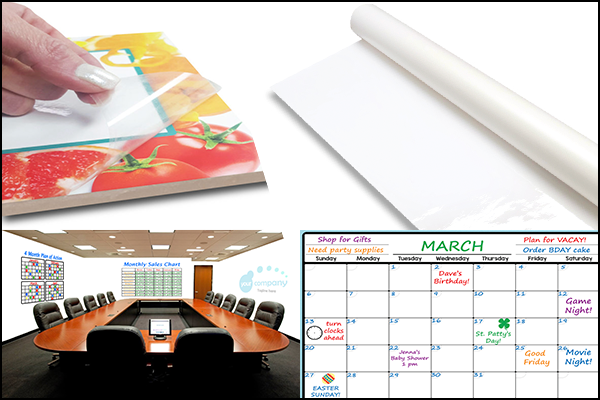
Whiteboard Material Comes in Various Forms
Blog, News & Events
By Dan Griffin Posted September 21, 2022
Pick from Among 4 Types of Dry Erase Material for Your Application
Whiteboard material generally refers to a type of dry erase surface. Someone looking for whiteboard material usually is looking to:
- Resurface an existing whiteboard,
- Turn a chalkboard into a whiteboard,
- Apply a dry erase surface to all or part of a wall,
- Overlay a removable dry erase surface onto an existing surface,
- Apply a clear, dry erase surface to another surface.
Four types of dry erase material are available for the above applications:
Dry Erase Material for Resurfacing a Chalkboard or Old Whiteboard
 Resurfacing is the most common use of whiteboard material. When chalkboards are no longer the preferred presentation surface in a room, or when the surface of existing whiteboards has become stained or ghosted, the most economical approach is to apply a new dry erase surface.
Resurfacing is the most common use of whiteboard material. When chalkboards are no longer the preferred presentation surface in a room, or when the surface of existing whiteboards has become stained or ghosted, the most economical approach is to apply a new dry erase surface.
Dry erase resurfacing material comes in rolls and commonly has a self-adhesive backing. The material is usually glossy and is manufactured to be impervious to ink from dry erase markers and, in some cases, to ink from permanent markers. Some manufacturers also offer resurfacing material with a matte surface that can be used as projection screen. However, users have found Everase’s glossy surface to be suitable as a projection surface.
On Everase’s glossy resurfacing material, erase marker ink can easily be wiped away with a micro-fiber cloth. For Everase’s low-gloss material, a damp cloth should be used to wipe away whatever is written or drawn on the surface.
Along with plain white resurfacing material, Everase offers rolls of whiteboard film with penmanship lines, music staff lines, and grids and graphs.
Whiteboard Panels
If you want a magnetic surface, a whiteboard panel might be your best option for resurfacing. Whiteboard panels have a dry erase surface and some sort of backing, such as a honeycombed cardboard and, in some cases, a steel sheet to provide a magnetic surface. Manufacturers who sell these panels, such as our sister company EVERWhite, usually offer them custom-cut to meet the exact dimensions of a buyer’s existing chalkboard or whiteboard frame.
Whiteboard Material to Cover a Wall
Another use for whiteboard material is to turn all or part of a wall into a dry erase surface. Like dry erase resurfacing material, whiteboard wall covering material comes in rolls of various lengths. And like resurfacing material, whiteboard wallpaper can be purchased with a glossy or matte surface. Everase manufactures its whiteboard wall covering with a non-woven backing. A non-woven backing provide a smoother surface for writing or drawing.
Unlike resurfacing material, an adhesive needs to be applied to the wall before some types of whiteboard wallpaper are installed. There are some self-adhesive wall coverings on the market, but those that require a pre-applied adhesive will do a better job standing up to regular use and are more appropriate when covering large areas of a wall.
Dry Erase Overlays
Another type of whiteboard material is a dry erase overlay. This material is manufactured to allow for non-permanent application on a surface. Overlays can be placed onto a surface and will stick there until they are peeled off. When they are removed, no adhesive is left on the surface, and the overlay can be re-placed on another surface. Some overlay material is magnetic, and uses magnetism to adhere to a surface, such a a refrigerator where an overlay with a to-do list, shopping list, or calendar could be applied. Overlay surfaces are generally very easy to clean. While overlays can be positioned onto whiteboard surfaces, they are not intended to be a resurfacing solution.
Everase offers dry erase overlays in its Re-Stic line and through dry erase laminates. The Re-Stic line includes plain white overlays as well as overlays with common, pre-printed designs such as to-do lists, calendars, planners and note-takers. Custom designs are available, too.
Dry Erase Laminates
Clear laminates are permanently applied to posters, signs and other surfaces to provide a dry erase surface. A polyester material provides the erasable surface. A pressure-sensitive adhesive permanently secures the laminate to a surface. Dry erase marker ink is easily wiped off a laminate sheet. This material is intended for use by other manufacturers, sign makers and printers who need to apply a dry erase surface and who have the equipment to properly adhere the laminate to the surface; it is not intended to be applied to existing whiteboards or as a substitute for dry erase resurfacing skins or for dry erase overlays.
So whatever need you have for a dry erase surface, there is a whiteboard material to meet your needs.
